Why are bowing walls taken so seriously by foundation repair experts? It’s because bowing walls are a clear sign something is wrong with your foundation, and you need repair as soon as possible. Your foundation is what’s holding up your home. So, if your foundation fails, your home fails as well. This article discusses what bowing walls are, four causes of bowing walls, and five of the most recommended expert solutions.
What Are Bowing Walls?
Is the center of your foundation wall pushing inward while the top and bottom seem to be staying put? This is what experts call bowing walls. Bowing walls can sometimes be accompanied by a long horizontal crack running along the center of your wall.
If you have concrete block walls, the bowing could even cause stair-step cracks. Stair-step and horizontal wall cracks are what experts call “structural cracks,” and they are very dangerous. Overall, bowing walls are a clear sign there’s pressure outside your foundation, and it’s causing your walls to move inward.
4 Causes Of Bowing Walls
Below are four of the most common causes of bowing walls.
- Expansive soil – If the soil around your foundation contains a lot of clay, it can swell and shrink based on moisture content. When the soil absorbs water, it grows and pushes against your walls. Then, when the soil dries, it shrinks and allows your wall to fall back outward. This back-and-forth movement is not good for your foundation walls, and can cause them to bow and crack. The American Society of Civil Engineers estimates that 1/4 of all homes in the United States have been affected in some way by expansive soils.
- Hydrostatic pressure – If water builds up around your foundation and is not correctly collected by a drainage system, it can cause the volume of the soil outside your walls to increase. This increase in volume will push against your foundation walls, causing them to bow inward. Hydrostatic pressure commonly affects homes that were built in an area with a high water table.
- Frost-heaving – When the soil outside your foundation freezes, two things can occur.
- The volume of the soil can increase, pushing against your walls and causing them to bow or crack.
- The soil can rise as it freezes, settling back down as it thaws. This up-and-down movement exerts pressure on your foundation walls, causing them to bow or crack.
- Lateral pressure from heavy objects – When a heavy object, such as a construction vehicle, is parked alongside your foundation, the weight can push down on the soil and press against your foundation walls. This pressure can cause your foundation walls to bow inward.
5 Solutions For Bowing Walls
Below are five of the most common ways professional foundation repair experts fix bowing walls.
Wall Plate Anchors – Wall plate anchors are designed to take pressure off your foundation wall and distribute it into the soil outside your home. They are minimally invasive, and the Chief Appraiser for the U.S. Department of House and Urban Development regarded them as the most effective means of stabilizing bowing walls. Here’s how they work.
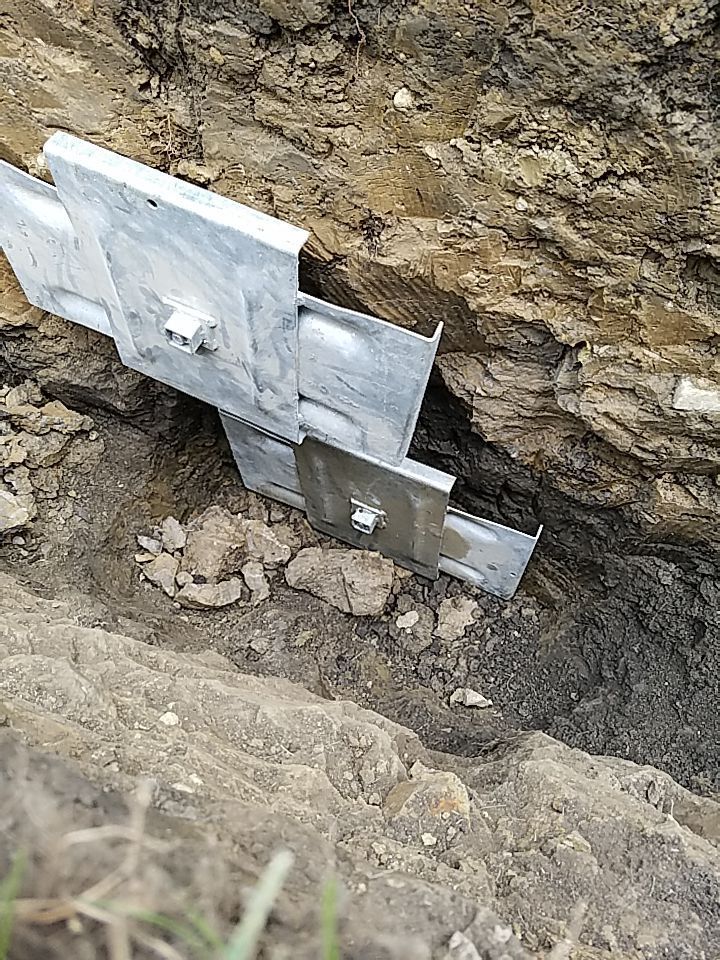
- Foundation repair experts will dig around your foundation wall, allowing your wall to move back outward once the repairs take place.
- Outside anchors are placed in a trench at least 13 feet away from your bowing wall.
- If your bowing wall is cracked into different sections, experts will attach carbon fiber straps along your wall. This ensures that the entire wall moves when the anchors pull your wall outward.
- Holes are drilled into your bowing wall. This is where threaded high-strength rods will be inserted, connecting the outside anchors to the inside wall plates.
- Hydraulic jacks are used to lift up your home, taking pressure off your foundation wall allowing it to move easier.
- The wall plate anchors are attached to the bowing wall, connecting to the high strength rod and outside anchor.
- Lastly, the wall plate anchors are tightened all at the same time using a torque wrench, pulling your wall back outward.
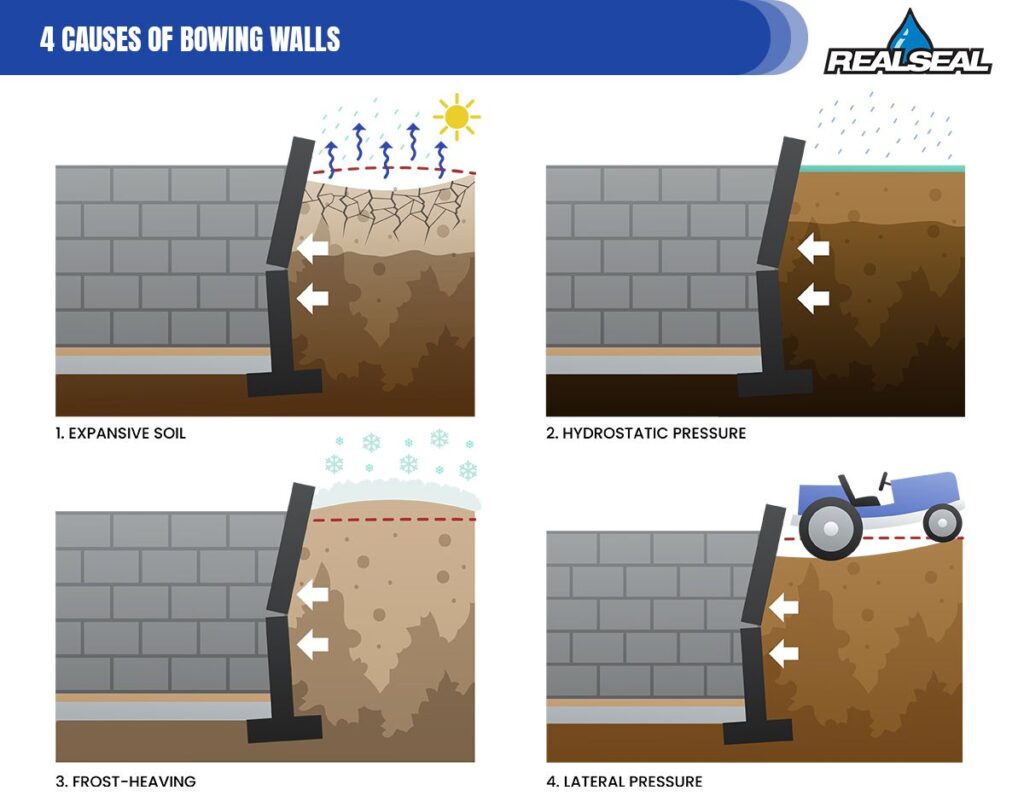
Fortress Invisibeam Carbon Fiber Straps – These carbon fiber straps can repair bowing and shearing walls. Made of one of the strongest fabric materials in the industry, carbon fiber straps won’t stretch or snap, creating a virtually unbreakable bowing wall solution. These specific straps can repair wall movement up to three inches. Other brands of straps can only repair movement up to two inches. Here’s how they work.
- A galvanized bracket is anchored to the beams at the top of your foundation. This is the first anchor point.
- The carbon fiber straps are placed against your bowing wall using epoxy and hundreds of small epoxy rivets. This cements the straps to your concrete wall, creating the strongest bond in the industry.
- Lastly, the bottom of the straps are installed to your foundation footer, creating a final anchor point.
Fortress Invisibeam carbon fiber straps come with the best warranty in the industry. Because of their reliability, The Real Seal warranties that if the straps fail, we will come out and replace them. This even includes replacing the entire foundation wall if needed.
C-channel Anchors – Unlike wall plate anchors, which use wall plates, c-channel anchors use long steel beams to stabilize your bowing wall. These anchors are mainly used for sheering walls (the top of the wall is moving inward while the bottom of the wall stays put). Here’s how they work.
- Large steel beams are placed against your sheering or bowing wall, placed every four to five feet from the center of one beam to another.
- Outside anchors are placed in a trench 13 feet away from the affected wall.
- Holes are drilled into your wall, allowing threaded high-strength rods to slip through and connect to the outside anchors.
- The steel beam and outside anchor are connected and torqued, pulling your wall back outward.
- Lastly, the steel beams are secured to your foundation footer, creating a final anchor point.
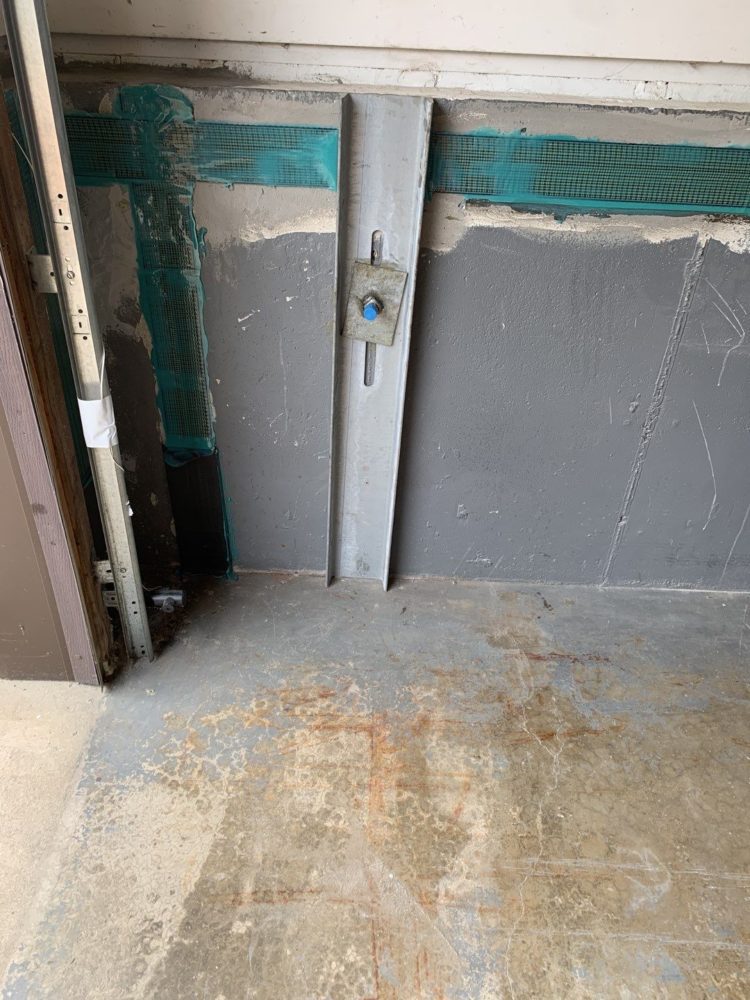
Epoxy Crack Injection – As we mentioned earlier, bowing walls can be accompanied by long horizontal cracks. After your wall is pulled back outward, the cracks will need to be filled using an epoxy injection. Here’s how they work.
- A surface patch is created using a strong epoxy bonder.
- The cracks are injected using a 2-part epoxy. This injection waterproofs and reinforces your foundation wall.
Helical Tieback Anchors (Not Provided By The Real Seal) – Like corkscrews, these anchors are drilled from inside your foundation wall, pulling your wall outward as the anchors twist. These anchors are perfect for foundations that have limited interior or exterior access.
Who Can Repair Bowing Walls Near You?
If you live in the Greater Chicago area and have bowing walls, you should call The Real Seal. Our team of experts will get you started with an in-depth inspection, free repair estimate, and a list of our finest solutions. We also provide basement waterproofing, crawl space encapsulation, crawl space repair, concrete leveling, and more.
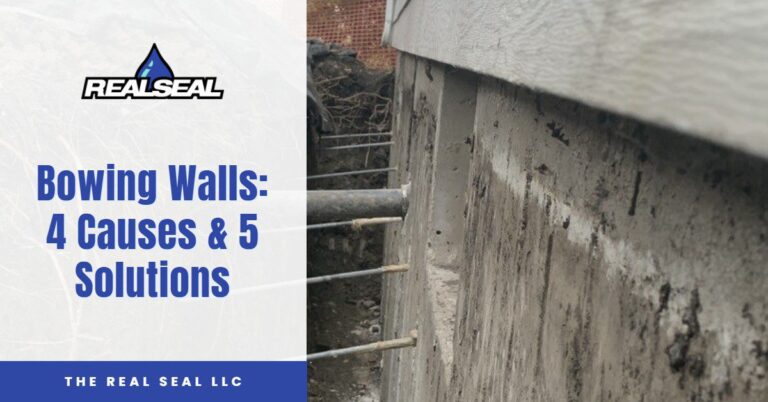
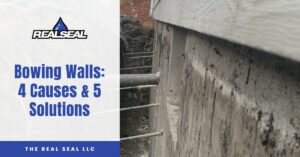





4 Responses
Live your video Can you recommend me a wall a foundation professional in mass
Thanks so much, G! Unfortunately we do not know anybody in the Mass area we would recommend. I would recommend comparing reviews on ALL review sites (Yelp, Google, BBB, Angie’s) and choosing the company who can sustain their reputation across all of them.
When using plates to straighten a bowing house wall, it appears you take out the soil next to that wall. Do you straighten the wall in one day? Do you replace the soil you removed with p-gravel?
Hi Karen!
We do straighten the wall in one day, once the system is completely set up. We move the soil on the other side of the wall to help create space for the wall to move freely. It is not a good idea to move the wall with the compacted soil against said wall.
The same soil that goes out goes back in. Once we have the plates, and especially Carbon Fiber, in place after the Wall Pushback, there is no fear of the wall moving back inwards. The extra cost of removing the soil and replacing with pea gravel is not something most homeowners want to undertake, especially when in the end it is the same result. We do waterproof the wall and will do a Drain Tile to stop water infiltration.